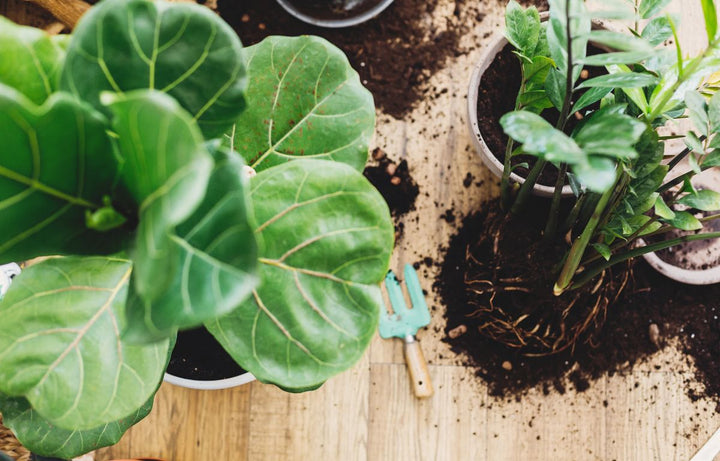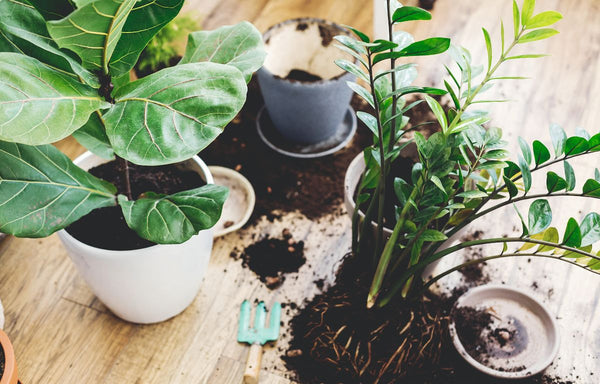
Why Repotting is Essential for Your Fiddle Leaf Fig
Why Repotting is Essential for Your Fiddle Leaf Fig
Fiddle Leaf Figs (Ficus lyrata) have surged in popularity as houseplants in recent years. With their large, glossy leaves and elegant presence, they can transform any room into a green oasis. However, if you want your Fiddle Leaf Fig to thrive, there's one crucial aspect of care you shouldn't overlook: repotting.

Why Repotting Matters
Repotting your Fiddle Leaf Fig is not just an optional task; it's a key factor in ensuring the health and growth of your beloved plant. Here's why it matters:
Room for Root Growth
Like any living organism, Fiddle Leaf Figs need space to grow, and their roots are no exception. As your plant matures, its roots expand to seek out nutrients and water. If left in the same pot for too long, it can become root-bound, where the roots coil around themselves, hindering growth and potentially causing stress to the plant. Repotting provides the necessary room for these roots to expand freely.
- Access to Fresh Nutrients
The soil in your plant's pot contains essential nutrients that your Fiddle Leaf Fig relies on for its growth and vitality. Over time, the soil becomes depleted as your plant absorbs these nutrients. Repotting allows you to refresh the soil with a nutrient-rich mix, ensuring your plant has access to the resources it needs to flourish.
- Pest and Disease Prevention
Indoor plants are susceptible to pests and diseases. Over time, pests like spider mites or diseases can take hold in the soil or on the plant's roots. Repotting allows you to inspect the root system and soil, providing an opportunity to remove any pests or diseases before they become a more significant problem.
When is the Best Time to Repot?
Timing is crucial when it comes to repotting your Fiddle Leaf Fig. The ideal time is during the spring or early summer when the plant is in its active growth phase. This ensures that your plant can quickly recover from the shock of being transplanted and adapt to its new environment. Avoid repotting during the winter months when the plant is dormant.

A Step-by-Step Guide to Repotting
Now that you understand why repotting is essential, let's go through the process step by step to ensure a successful transplant:
Step 1: Gather Your Materials
To repot your Fiddle Leaf Fig, you'll need the following:
- A larger pot with drainage holes.
- Fresh, well-draining potting mix.
- Pruning shears or scissors.
- Gloves
Step 2: Prepare the New Pot
Choose a pot that is 2-4 inches larger in diameter than the current pot. Make sure it has drainage holes to prevent waterlogging. Begin by filling the bottom of the new pot with a layer of fresh potting mix.
Step 3: Remove the Fiddle Leaf Fig from its Current Pot
Gently tilt the plant to one side and tap the pot to loosen the root ball. Carefully slide the plant out while supporting the base of the stem with your hand. If the roots are tightly bound, use your fingers or a tool to loosen them slightly.
Step 4: Prune the Roots (if necessary)
If you notice roots circling around the root ball or overcrowding, it's beneficial to prune them. Trim off any damaged or excessively long roots using clean pruning shears or scissors. This encourages new root growth.
Step 5: Place the Plant in the New Pot
Position the Fiddle Leaf Fig in the centre of the new pot. Add fresh potting mix around the sides, ensuring the plant is at the same depth as in the previous pot. Gently press the soil to secure the plant in place.
Step 6: Water and Settle the Plant
Thoroughly water the plant until water drains out of the bottom. This helps settle the soil and removes any air pockets around the roots. Be cautious not to overwater, as this can lead to root rot.
Step 7: Care After Repotting
Place your repotted Fiddle Leaf Fig in a bright, indirect light location, avoiding direct sunlight that can scorch the leaves. Maintain regular watering, allowing the top inch of soil to dry out before watering again. Monitor the plant for any signs of stress or adjustment and hold off on fertilising for a month.
You may also enjoy reading about plant propagation or our indepth post about Fiddle Leaf Figs
